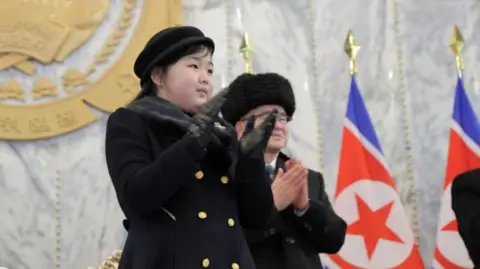Kim Jong Un Brings Young Daughter to Beijing as North Korea Signals Possible Heir
Kim Ju Ae, whose age and exact role remain unclear, has appeared increasingly at public state events and was pictured alongside her father during his visit to China.
North Korean leader Kim Jong Un brought his young daughter to Beijing this week, appearing with her as he attended Chinese commemorations and a major military parade, an appearance South Korea’s spy agency says underscores growing signs she may be being positioned as a successor.
South Korea’s National Intelligence Service has identified the girl, believed to be Kim Ju Ae, as the most likely heir to Kim Jong Un. Her exact age and status are not publicly confirmed; South Korean officials and open-source accounts place her birth around 2013, making her roughly 12 or 13 years old. North Korean state media have described the child as "beloved" and "respected" but have not published her name in official reports.

Details about Kim’s family have long been tightly controlled by the North Korean leadership. Kim Ju Ae is the only child whose existence has been confirmed publicly by state media. Analysts and South Korean intelligence officials believe Kim Jong Un and his wife, Ri Sol Ju, also have other children, including an older son and a younger child, but those reports remain unverified in the absence of public appearances.
The name "Ju Ae" ascribed to the girl in open reporting traces in part to an anecdote by former U.S. basketball player Dennis Rodman, who said he had held Kim’s baby daughter on a 2013 visit to Pyongyang. The girl’s first widely noted public introduction came in 2022, and she has since appeared at several high-profile domestic events that have bolstered speculation about her role in succession planning. Photographs released by North Korean state media have shown her at military ceremonies and other official occasions alongside her father.
Kim’s appearance in Beijing marked one of her first public outings abroad. She was seen following her father off his armored train as both were welcomed by Chinese Communist Party officials ahead of a parade marking the 80th anniversary of Japan’s surrender in World War II. State photos showed her in formal dress standing close behind Kim as he greeted host officials. North Korean images also showed the pair at a warship ceremony in June, demonstrating a pattern of public appearances that analysts say highlight a deliberate effort to associate the girl with the regime’s institutions.
North Korea has a recent history of dynastic succession: the state was founded by Kim Il Sung and subsequently led by his son Kim Jong Il before power passed to Kim Jong Un. Analysts note the regime has often groomed family members and close associates through staged public roles and state propaganda, while withholding personal details and formal titles until a transition is formalized. How — or whether — such a transition would be accomplished in the future remains a matter of interest to regional governments and analysts.
A closed-door briefing to South Korean lawmakers in 2023 by the country’s main spy agency said it believed Kim Ju Ae was being prepared for leadership. That assessment has been echoed in reporting and commentary since her introduction to public view. Some outside experts caution that formally designating a young family member as a successor can be part of statecraft in North Korea, but they also warn that public grooming of a child carries risks, including psychological pressures, without clear precedent for how the regime would manage a transition involving a minor.

Observers will be watching for any formal appointments, titles or public roles that might clarify the girl's status. North Korea’s official announcements, if any, tend to be tightly choreographed and can arrive only after the leadership has settled its internal succession calculations. For now, the repeated public appearances of Kim Ju Ae alongside her father and the characterization of her by state media and foreign intelligence have elevated international attention on the future leadership prospects in Pyongyang.
Kim Jong Un’s visit to China also carries strategic significance beyond the optics of succession. The trip, his most prominent foreign engagement in years, comes as Pyongyang balances relations with traditional allies including Beijing and Moscow amid heightened tensions over its nuclear arsenal. How the North moves forward on succession, and whether it will publicly name a successor or continue to present familial ties without formal appointments, will be among the questions shaping diplomatic and intelligence assessments in the region in the months ahead.